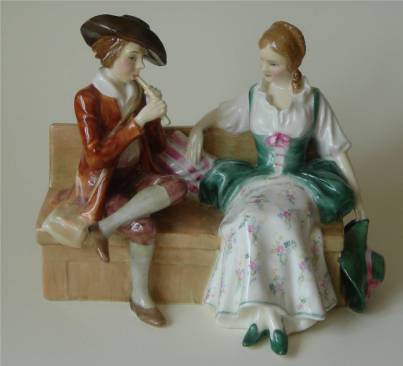Figure adaptations by Christopher Evans
As all figure collectors know, during the design process prototypes followed by pilot figures are produced and these models can change in their modelling quite simplistically or quite dramatically at this early stage.
Here is a prototype I once saw and then a few months later saw a version with her holding a mask rather than the mirror you see below.
However, once a figure has gone into production that does not mean that further adaptation and transformation is not possible nor can this be ruled out!
At no other time and to no other group of figures does this more aptly apply than to those of the 1920’s and 1930’s. With production dates for this period being so sketchy one can only attempt to draw conclusions as to the precise dates of withdrawal and sometimes even introduction.
Sweet Maid (above) became Millicent (below)
This is of particular relevance to a group of figures which are clear adaptations of existing figures. Take for example Harradine’s Sweet Maid HN1504 (1932 LH) which became Millicent HN1714 (1935 LH) or his Helen HN1509 (1932 LH) which became June HN1690 (1935 LH).
The Windmills Lady (above) who became Old Lavender Seller (below)
The scarcity of the former in both cases suggests that the latter may have replaced these earlier models. Then again, we have The Windmill Lady HN1400 (1930 LH) and The Old Lavender Seller HN 1492 (1932 LH). Clearly the old lady is the same in both figures with minor adaptation. Both figures were produced simultaneously, as were the Rustic Swain HN 1745 (1935 LH) and Midsummer Noon HN1899 (1939 LH). It was not just Harrading who adapted their own earlier models.
The Rustic Swain (above) which became the solitary Midsummer Noon (below)
However this tendancy to adapt existing figures can be traced back to even the earliest times of Doulton figure production in the early 20th Century and then the introduction of the HN figure range. Consider Noke’s reintroduction of the many Jesters he had produced earlier in Vellum and then Tittensor’s Pretty Lady HN69 (1916 HT) and The Parson’s Daughter HN 337 (1919 HT) which both have clear similarities in the modelling of their skirts.
Existing models were not only adapted but also changed size and renamed, such as Biddy HN1445 (1931 LH) and Rita HN1448 (1931 LH), or Doris Keane HN90 (1918 CJN) and Rosamund HN1497 (1932 LH).
Here we have a hard paste porcelain version of Doris Keane by John Broad made at Doulton’s Lambeth factory in the early 20th Century, together with her miniature self M32 made at their Burslem factory in the 1930’s
It is worth noting a little something about the production dates given to figures and that in my experience the date of ‘by 1949’ is rarely the case, indeed ‘by 1944’ would be much more accurate, with the exception of a handful of the most popular figures of the time such as Paisley Shawl HN1392, Autumn Breezes HN1934, Top o’ the Hill HN1849, The Orange Lady HN 1759 and Biddy Penny Farthing HN1843, whose production continued into 1944 and was resumed soon after the end of WWII principally , if not solely for the export market; more precisely for the USA and Canada.








Reblogged this on doultoncollectorsclub.
LikeLike